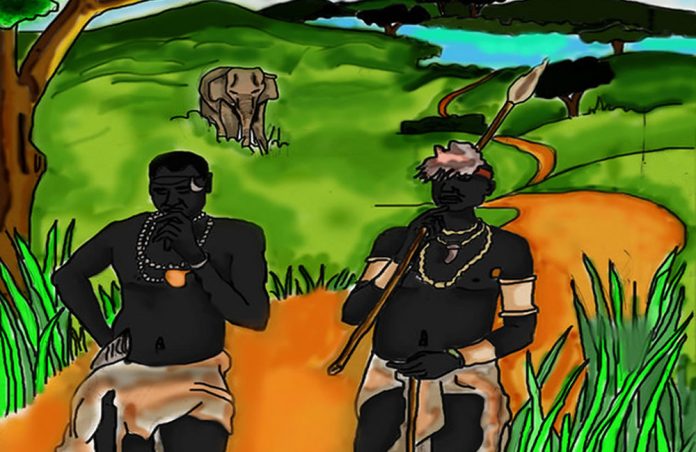Gipir and Labongo, what a time-old legend! Dating far back into the 15th Century, its climax sits atop a spot on the Albert Nile called Wang-Lei. With a genesis almost dismissable, this story is so pertinent. See, back then, each Luo family had an ancestral spear it held a very strong attachment to. It was a symbol of leadership and authority.
As culture demanded, it used to be passed on by the family head from one generation to another. The practice signified the continuation of the lineage. In most cases, the recipient would be the firstborn son of the family. On the other hand, the second-born would be given royal beads, a symbol of grace.
When it dawned on Gipir and Labongo’s father that he would be dying soon, he called his two sons to his death bed for the last blessing. The biggest highlight of the event was the handover of the family spear to Labongo as he was the elder son. Gipir on the other hand was given beads as he was a junior.
One chilly morning, an elephant invaded a backyard garden belonging to Labong, who at the time had gone on a hunting spree. The garden had pigeon peas, a favorite delicacy to the giant mammals.
Upon seeing the elephant, Labongo’s wife made an alarm crying for help. Gipir who happened to be at home dashed into the house of Labongo randomly picked the nearest spear, and enthusiastically stabbed the elephant. The sharp-tipped spear sank so deep into the elephant’s body.
Startled, the elephant fled out of sight into a distant forest in agony. It turned out that he had been struck using the legendary spear. Dr. Edwin Wathum Jalusiga, former Prime Minister Alur Kingdom and a lecturer at Kyambogo University say that this is when all hell begun to break loose.
He insists that it is the disappearance of said elephant that birthed this story really. See, it didn’t go well with Labong who was greeted with the news upon return from the hunt, not one bit! “His blood boiled with fury,” Dr. Jalusiga says.
He says that without the slightest consideration of to fact that the move was done with good intentions, Gipir ordered his brother to follow the elephant and recover the regalia. He was to never return in the event that his pursuit ended in vain. Gipir’s pleas to replace the spear with another one fell on deaf ears.
Left with no choice, he eventually submitted to the request and left for the forest amidst despair that he wouldn’t make it back alive. See, the forest was a habitat for various beastly predators. Venomous snakes, forest leopards, buffaloes, and lots more.
Plot Thickens
This plot, like gravy, thickens. See, the further into the forest he went, the more sore his legs got, he couldn’t walk anymore. Soon the sores would get infected, leaving him I’ll and alone in a forest. He was stuck in there for weeks with no one to help him.
Then a miracle happened; an old kind woman to whom the forest was home came to his rescue. Day after day, she nursed him till he was able to get up on his own. Thanks to the reinforcement by this Samaritan, he was able to arise on his feet and track the elephant with guidance from the Samaritan woman.
He eventually found it lying dead in the middle of the forest. Upon return, Labongo awaited a ripe opportunity for revenge. His wait wasn’t in vain. One day, one of his royal beads was picked and swallowed by one of Labongo’s daughters.
“He couldn’t be happier demanding for the bead-like his whole life depended on it.” Gipir’s cry to make it up to him didn’t yield fruit. There was only one way out. He was to slit his child’s stomach open, killing her, after which he was to pick bead. It was a painful sacrifice as the victim was his favorite child.
Wang-Lei is born
A defeated Gipir, afraid that the worst awaited if he stayed with his brother, decided it was time to go their separate ways. To cement the decision, they buried an axe at the spot where the present-day Wang-Lei is; just a few meters from Pakwach bridge opposite the former railway quarters. Wang lei is basically the axe
Gipir would go on to migrate with his family to the present day Great West Nile region and some parts of Congo, Labongo headed to Northern Uganda. Gipir’s group went on to form the Alur tribe while Labongo’s formed the Acholi. “Since the split, never in history has anyone from the Labong lineage successfully crossed this bridge. To be specific, anyone with ill motives against the people of West Nile,” Jalobo Omulemezi, a spiritualist at the site who has lived in Pakwach for the last 48years says.
He explains that when the warrior priestess Alice Lakwena and her troops attempted to cross over it in the Mid-1980s-so as to terrorize the West Nile fraternity, over 30 of her troops mysteriously fell off the bridge and drowned, never for their bodies to be recovered.
Similarly, when the Lord’s Resistance Army Rebels followed suit in the late 1980s, they also lost several of their troops mysteriously, never to be found again.
Hardly has a year ever gone by without someone drowning at the bridge. Though no convincing answer has been found to this question, Omulemezi suspects that these victims were possibly up to mischief when crossing the bridge, no more!










